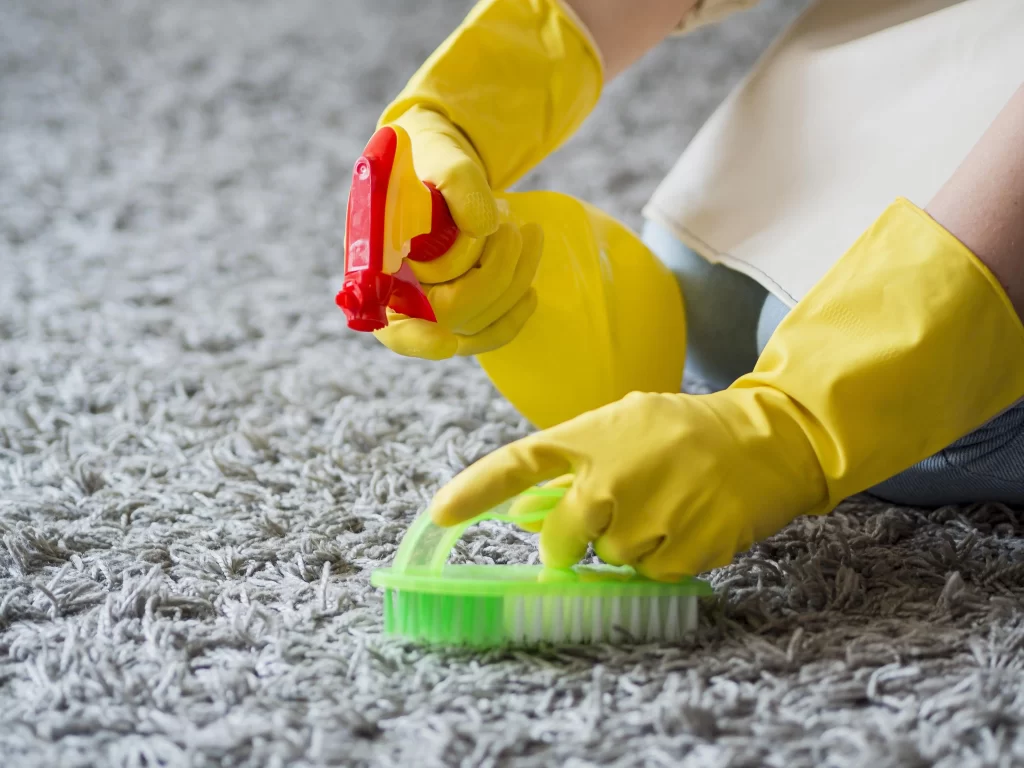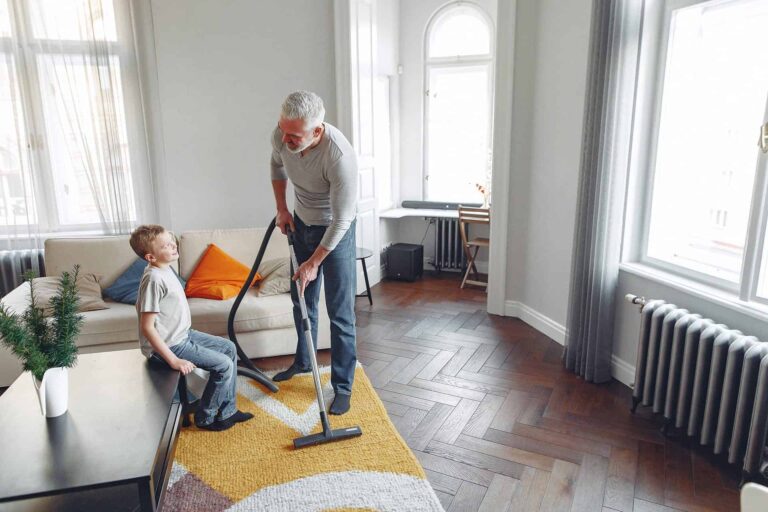You’ve just spent hours precisely cleaning your favorite carpet, hoping to bring back its vivid colors and cozy texture. But, as you wait for it to dry, you discover an irritating problem: your carpet is not drying after cleaning. Fear not as you explore this wet mystery! In this post, we will reveal why carpets sometimes refuse to dry and present you with useful insights and remedies to this wet problem. So, join me on a voyage through the soggy world of carpets to uncover the patterns that explain their resistance to dry after a thorough cleaning.

Carpet Not Drying After Cleaning
It might be inconvenient when carpets do not dry correctly after washing. Environmental circumstances, cleaning practices, and carpet composition can all contribute to this problem. look at the most prevalent causes of carpets not drying after washing and examine potential solutions.
- Insufficient Airflow:
A lack of airflow is one of the most common causes of carpets taking longer to dry after cleaning. Moisture persists in carpets not exposed to appropriate air circulation, resulting in longer drying times. This problem is especially common in enclosed or poorly ventilated locations, such as basements or rooms with few windows.
Solution:
Open windows and use fans or dehumidifiers to ensure appropriate ventilation in the cleaning area. Improved ventilation aids in the evaporation process and speeds up carpet drying.
- Excessive Moisture Consumption:
Excessive use of water or cleaning solutions during the cleaning procedure can result in lengthy drying durations. Oversaturating the carpet can cause moisture to penetrate deeper into the carpet fibers and underlying padding, making it more difficult to dry completely.
Solution:
Follow the manufacturer’s water and cleaning solution usage guidelines and recommendations. Use a carpet extractor or steam cleaner to remove excess moisture while offering a thorough cleaning.
- Conditions of Humidity and Weather:
Environmental conditions heavily influence carpet drying. High humidity levels impede evaporation, making it harder for the carpet to dry properly. Unfavorable weather conditions like rain or freezing temperatures can also contribute to longer drying periods.
Solution:
Choose a day with low humidity and favorable weather conditions to ensure optimal drying. Run dehumidifiers or air conditioners to minimize indoor humidity levels during drying.
- Insufficient Extraction:
Inadequate moisture extraction during the cleaning procedure might leave residual moisture in the carpet, causing it to dry slowly. Inadequate extraction can occur due to utilizing equipment with insufficient suction power or failing to spend enough time on each region of the carpet.
Solution:
Invest in high-quality carpet cleaning equipment that can extract water. Make numerous passes over each part of the carpet during the cleaning procedure to ensure proper extraction.
- Carpet Composition and Thickness:
A carpet’s composition and thickness can impact the drying time. Carpets with more padding or density soak up and retain water for longer. Furthermore, certain carpets, such as wool or natural fiber, may require special attention throughout drying.
Solution:
Keep the carpet’s composition and thickness in mind when cleaning. If you have dense or densely cushioned carpets, modify your cleaning procedure and allow additional time for drying. Consider expert cleaning services that specialize in managing delicate or natural fiber carpets.
How to Dry a Carpet After a Leak:
A situation where a leak has caused a wet carpet can be upsetting. Act swiftly to dry the carpet to prevent mold and mildew formation is critical. Here are some tips for effectively drying a carpet after a leak:
Identify and Stop the Leak: Before treating the wet carpet, it is critical to discover and repair the source of the leak. This could result from a leaky pipe, a dripping roof, or any other water source. Please turn off the water or fix the leak to stop further flooding.
Remove Standing Water: If there is substantial standing water on the carpet, extract as much water as possible with a wet-dry vacuum or a pail filled with towels. To prevent the spreading of the water, begin in the center and work your way outward.
Elevate Furniture and Remove Obstructions: Remove any furniture or anything on the damp carpet to prevent further damage and create a free drying space.
Increase Air Circulation: Allow fresh air to circulate in the space by opening windows and doors. Place fans to blow air directly onto the wet carpet, and consider strategically arranging them to provide cross-ventilation.
Use Absorbent Materials: On the damp carpet, use absorbent towels, clean rags, or even newspapers. Press them down gently to absorb moisture. Replace them with dry towels, repeating the process until the towels no longer absorb water.
Use Baking Soda: liberally sprinkle baking soda on the soaked carpet. Baking soda absorbs moisture and eliminates odors.
Monitor and Rotate the Carpet: Check the drying progress regularly and rotate the carpet as needed. This ensures that all sections of the carpet receive adequate ventilation and drying time.
Professional Help: If the carpet stays extremely wet or you fear serious water damage, it is best to seek professional assistance. Water damage restoration professionals have the knowledge and specialized equipment to dry the carpet and fully solve any underlying concerns.
How to Dry a Wet Carpet Without Using a Vacuum:
If you don’t have a vacuum cleaner, you can still dry a damp carpet with other means. Here are a few methods:
Blotting the damp Carpet: Blotting the damp carpet with clean, absorbent towels. Firmly press down to absorb as much moisture as possible. Repeat with dry towels until the carpet is damp rather than wet.
Broom or mop: Gently push and pull across the carpet with a clean broom or mop. This action can aid in the removal of moisture from carpet fibers. Make sure it is clean before using a broom or mop on the carpet.
Fans and ventilation: Allow fresh air to enter the room by opening any nearby windows or doors. Install fans in strategic locations to blow air over the moist carpet.
Dehumidifiers: Carpets can dry more quickly because of the use of dehumidifiers, which remove excess moisture from the air.
FAQs
How to dry a damp carpet fast?
Use fans or air movers to promote air circulation in the space to fast dry soggy carpet. Blotting the carpet with absorbent towels or using a wet-dry vacuum can also aid in the removal of moisture.
How long does it take for the carpet to dry after shampooing?
The drying time for a carpet after shampooing can vary based on several factors, including the thickness of the carpet, humidity levels, and ventilation in the space. After shampooing, a carpet might take 6 to 24 hours to dry properly. However, employing fans or air movers and providing adequate ventilation might help accelerate the drying process.
How long does it take for a Bissell carpet to dry?
The drying period after using a Bissell carpet cleaner is comparable to shampooing. After using a Bissell cleaner, the carpet may take 6 to 24 hours to completely dry. To aid in the drying process, the same ideas of employing fans, providing sufficient ventilation, and removing excess moisture apply.
Can you walk on a damp carpet after it has been cleaned?
I was walking on a damp carpet shortly after washing is not advisable. Walking on a wet carpet can force dirt and debris deeper into the fibers, causing staining or damage. If required, build a path on the carpet with temporary pathways or plastic sheets to minimize contact while it cures.
Conclusion
The wet carpet remains damp and refuses to dry entirely despite being thoroughly cleaned. Several things, including high humidity levels, insufficient ventilation, or faulty drying equipment, could cause this aggravating condition. Addressing this issue as soon as possible is critical to avoid mold growth, unpleasant odors, and further damage to the carpet and surrounding spaces. Seeking professional aid or using different drying procedures may be required to ensure the total restoration of the carpet and the return of a clean, dry, and healthy environment.

